UToledo Scientist Developing Single Drug to Treat Diabetes, Osteoporosis
November 29th, 2021 by Tyrel LinkhornWhen Dr. Beata Lecka-Czernik joined The University of Toledo College of Medicine and Life Sciences in 2007, her field was seen by many as something of a curiosity.
A professor in the Department of Orthopaedic Surgery with a joint appointment in the Department of Physiology and Pharmacology, Lecka-Czernik studies the connection between bone health and metabolic processes, including disorders such as diabetes.
“At that time, there were very few people believing there even was an intersection,” she said. “It was novel research, but it has really made a lot of progress with time.”
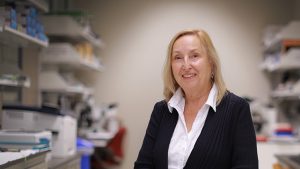
Dr. Beata Lecka-Czernik
Much of that progress has come from her own lab, which has made key discoveries about how some drugs used to treat diabetes can accelerate bone loss, and how a protein called PPAR-gamma that helps regulate insulin sensitivity also plays a role in the formation of new bone.
This fall, Lecka-Czernik received a five-year, $3.4 million grant from the National Institute on Aging to continue her work that’s ultimately aimed at developing a single therapeutic that could both normalize glucose levels and improve the mass and quality of bone.
Osteoporosis and Type 2 diabetes are both widespread in the United States. The National Institutes of Health estimates that 26 million Americans have Type 2 diabetes and twice that many either have or are at high risk of developing osteoporosis.
What’s more, weak bones and diabetes are often seen together. Lecka-Czernik said research has shown that diabetics suffer twice as many bone fractures as individuals without diabetes.
Her research team, which includes scientists from the Scripps Research Institute, will focus on better understanding the mechanisms of how processes in the bone are integrated with regulation of energy metabolism as they work to fine-tune an experimental drug they previously developed.
That compound, which has been patented by Scripps and UToledo, was found to be effective at regulating glucose and strengthening bone in a 2016 study published in the journal EBioMedicine.
Far from serving as a static scaffolding that supports our bodies, bones are constantly changing. One type of cell breaks down old bone and another type of cell creates new bone.
“You can think of it almost like a road crew,” Lecka-Czernik said. “One crew tears up the old pavement and the next crew comes along to lay new blacktop. In normal situations, they are coupled. As we age the destruction crew speeds up but the paving crew slows down, particularly in post-menopausal women.”
Most of the available therapeutics aimed at improving bone quality focus on slowing down resorption, or the process that breaks down old bone.
There is a relatively new drug that helps activate the cells responsible for building new bone by inhibiting the protein sclerostin, but Lecka-Czernik said some scientists have concerns that this drug may have a negative effect on the vascular system.
By targeting PPAR-gamma, which controls the expression of sclerostin, the experimental therapeutic she and her collaborators are investigating potentially gets around that concern.
And unlike some other insulin synthesizers that have been shown to speed up bone loss, the group’s experimental drug appears to do the opposite — building up healthier, stronger bones.
“If you have one pill that can take care of two pathologies which are common and often seen together, that could have a big impact for health. It could also have an economic impact, especially for the elderly who are spending a lot of money on prescription drugs,” she said. “Thirteen years ago, this was science fiction. Now it seems like a real possibility.”
Emotional Intelligence Proves Significant to Remote Leadership in a Crisis
November 22nd, 2021 by Christine BillauFrom employee morale to virtual fatigue and people not using their cameras, managers navigated a wide variety of issues when thrust into leading remotely during the COVID-19 pandemic.
New research from The University of Toledo conducted during the pandemic found that individuals with higher levels of emotional intelligence experienced lower levels of concern for leading remotely during the crisis.
“Prior to the global pandemic, most leaders did not have any formal training or on-the-job learning experiences related to leading remotely in a crisis situation,” said Dr. Jenell Wittmer, associate professor of management in UToledo’s John B. and Lillian E. Neff College of Business and Innovation and an industrial and organizational psychologist. “The results of our analysis confirm how effectively perceiving and managing one’s emotions contribute to effectively dealing with the challenges of leading remotely in crisis situations.”
The research demonstrates how emotional intelligence — especially the areas of self-perception and stress tolerance — can help leaders overcome their concerns about leading remotely to help them provide better communication, support, engagement and direction to employees who report directly to them.
The study titled “Leading Remotely in a Time of Crisis: Relationships with Emotional Intelligence” is published in a special issue of the Journal of Leadership and Organizational Studies that focuses on leadership through the COVID-19 pandemic.
“The COVID-19 crisis has tested even the strongest leaders, both personally and professionally,” said Dr. Margaret Hopkins, professor of management and co-author of the research. “Our study provides insights into how emotional intelligence provides a personal resource to leaders as they navigate leading remotely during a time of crisis.”
The study highlights the need for individual leaders to strengthen their emotional intelligence through activities such as self-reflection and 360-degree assessment instruments, as well as the need for organizations to invest in emotional intelligence development for their leadership teams by providing resources for training, strengthening the organization’s overall resilience.
“What leaders need especially during this type of crisis is not only a predefined response plan but more importantly behaviors and mindsets that will assist them in looking towards the future,” Hopkins said.
More than 200 people from a wide variety of industries in the Midwest participated in the study by completing two surveys, one related to leading remotely in a crisis and the second measuring their emotional intelligence.
The emotional intelligence assessment was completed for executive coaching purposes before the pandemic, between September of 2017 and March of 2020.
There are five components to emotional intelligence:
- Self-perception, which measures one’s self-awareness of emotions;
- Self-expression, or being assertive about expressing emotions appropriately;
- Interpersonal, which measures one’s ability to have effective interpersonal relationships;
- Decision-making, which measures problem-solving and reality testing; and
- Stress management, the ability to effectively handle stress.
During the pandemic, those same professionals participated in the survey about their experiences leading remotely. At the time of the survey, 82% reported that their current leadership was 100% remote, and 85% reported that COVID-19 was the first time they led remotely.
Nearly all of the participants cited transparent communication as being important during times of crisis and the general consensus about virtual meeting platforms is that they’re a “necessary evil.”
“We found that while operational issues are certainly important to address, the human elements are even more essential since the operational issues are influenced by people and their emotional reactions,” Wittmer said.
In particular, the ability to understand oneself and to manage one’s emotions, measured
by the self-perception and the stress management scales of emotional intelligence, were the two most significant components contributing to leading remotely in a crisis.
“Leaders with a high degree of self-perception will be more likely to pause before taking any
overly emotional or rash actions,” Hopkins said. “These leaders will tend to avoid being emotionally hijacked and allowing their emotions to govern their decision-making in these trying times.”
The research shows leaders with a higher degree of optimism will be more resilient in stressful times, which contributes to providing themselves and their staff with a clarity of purpose and mission.
“Crisis situations are by definition stressful times, which include strong emotions, time pressures, high stakes and ambiguity regarding solutions,” Wittmer said. “Leaders who exhibit adaptability will be more open to creative solutions as opposed to relying on their operational comfort zone.”
“There are three clear distinctions when simultaneously leading remotely and during a crisis situation: the degree of urgency, the level of uncertainty, and the presence of strong emotions with the possibility for intense emotional reactions,” Hopkins said. “All three of these generate increased pressures on the leader and create the potential for a perfect storm.”
Astronomers Team up to Create New Method to Understand Galaxy Evolution
November 16th, 2021 by Christine BillauA husband-and-wife team of astronomers at The University of Toledo joined forces for the first time in their scientific careers during the pandemic to develop a new method to look back in time and change the way we understand the history of galaxies.
Until now forging parallel but separate careers while juggling home life and carpooling to cross country meets, Dr. Rupali Chandar, professor of astronomy, and Dr. J.D. Smith, director of the UToledo Ritter Astrophysical Research Center and professor of astronomy, merged their areas of expertise.
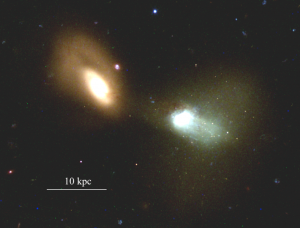
S12, a post-starburst galaxy located nearly 500 million light years away, is on the right. It looks like a jellyfish with a host of stars streaming out of the galaxy on one side.
Working along with UToledo alumnus Dr. Adam Smercina who graduated with a bachelor’s degree in physics in 2015 and is currently a postdoctoral researcher at the University of Washington, they used NASA’s Hubble Space Telescope to focus on a post-starburst galaxy nearly 500 million light years away called S12 that looks like a jellyfish with a host of stars streaming out of the galaxy on one side.
Smercina, the “glue” that brought Smith and Chandar together on this research, worked with Smith as an undergraduate student starting in 2012 on the dust and gas in post-starburst galaxies.
While spiral galaxies like our Milky Way have continued to form stars at a fairly steady rate, post-starburst galaxies experienced an intense burst of star formation sometime in the last half billion years, shutting down their star formation.
The resulting breakthrough research published in the Astrophysical Journal outlines their new method to establish the star formation history of a post-starburst galaxy using its cluster population. The approach uses the age and mass estimates of stellar clusters to determine the strength and speed of the starburst that stopped more stars from forming in the galaxy.
Using this method, the astronomers discovered that S12 experienced two periods of starburst before it stopped forming stars, not one.
“Post-starbursts represent a phase of galaxy evolution that is pretty rare today,” Smith said. “We think that nearly half of all galaxies went through this phase at some point in their lives. So far, their star-forming histories have been determined almost exclusively from detailed modeling of their composite starlight.”
Smith has studied post-starburst galaxies for more than a decade, and Chandar works on the stellar clusters in galaxies that are typically about three or four times closer than those in Smith’s data.
“Clusters are like fossils — they can be age-dated and give us clues to the past history of galaxies,” Chandar said. “Clusters can only be detected in these galaxies with the clear eyed-view of the Hubble Space Telescope. No clusters can be detected in even the highest quality images taken with telescopes on the ground.”
Smith has led several large multi-wavelength projects to better understand the evolutionary history of post-starburst galaxies. He discovered, for example, that the raw fuel for star formation — gas and dust — is still present in surprising quantities in some of these systems including S12, even though no stars are currently being formed.
“While studying the light from these galaxies at multiple wavelengths has helped establish the time that the burst happened, we hadn’t been able to determine how strong and how long the burst that shutoff star formation actually was,” Smith said. “And that’s important to know to better understand how these galaxies evolve.”
The astronomers used well-studied cluster masses and star formation rates in eight nearby galaxies to develop the new method, which could be applied to determine the recent star formation histories for a number of post-starburst systems.
The researchers applied their different approach to S-12, which is short for SDSS 623-52051-207, since it was discovered and catalogued in the Sloan Digitized Sky Survey (SDSS).
“It must have had one of the highest rates of star formation of any galaxy we have ever studied,” Chandar said. “S12 is the most distant galaxy I’ve ever worked on.”
The study indicates star formation in S12 shut off 70 million years ago after a short but intense burst formed some of the most massive clusters known, with masses several times higher than similar-age counterparts forming in actively merging galaxies. The method also revealed an earlier burst of star formation that the previous method of composite starlight modeling could not detect.
“These results suggest that S12’s unusual history may be even more complicated than expected, with multiple major events compounding to fully shut off star formation,” Smith said.
The research was funded by the National Science Foundation and NASA.
Chandar and Smith are two of four UToledo astronomers leading some of the first research projects on NASA’s new James Webb Space Telescope scheduled to launch in December.
Expectation shapes reality: Psychological factors predict COVID vaccine side effects
November 8th, 2021 by Tyrel LinkhornNausea. Chills. Fatigue. Headache.
Before getting vaccinated against COVID-19, many of us braced for the minor but uncomfortable side effects we’d heard so much about in the news or from our friends and neighbors who had already received the jab.
New research led by The University of Toledo suggests how much attention people pay those fears may predict how poorly they’ll feel post-vaccine.
In a paper published last week in the journal Psychotherapy and Psychosomatics, researchers detailed for the first time a link between the side effects people expected from COVID-19 vaccination and those they actually experienced.
“It’s important to see how psychological variables may be correlated to how people respond to these vaccines,” said Dr. Andrew Geers, professor in the UToledo Department of Psychology and the paper’s lead author. “Our research clearly shows that people who expected symptoms like headaches, fatigue or pain at the injection site were much more likely to experience those side effects than those who did not anticipate them.”
Geers’ lab specializes in the study of social psychology theory within health and medical contexts, including the psychology of drug side effects, placebo effects and nocebo effects.
While it’s well documented in the scientific literature how psychosocial factors can impact the success or side effects of a given treatment, no one had yet done so in the context of COVID-19 vaccines.
In April, Geers and his colleagues distributed a survey asking unvaccinated adults in the United States about their expectation for seven common vaccine side effects that had been widely publicized by the U.S. Centers for Disease Control and Prevention — pain at the injection site, fever, chills, headache, join pain, nausea and fatigue. The survey also collected socio-demographic information and assessed participants’ symptoms of depression and general worry about the pandemic.
Over the next three months, researchers followed up with 551 now fully vaccinated participants to ask which of the seven previously identified side effects they experienced.
“We found a clear link between what people expected and what they experienced,” said Kelly Clemens, a UToledo doctoral student studying experimental psychology and paper co-author. “Those psychological factors are predictive over and above the other factors that we knew were involved in predicting side effects, such as the specific vaccine someone received, their age or whether they previously had COVID-19.”
In addition to helping to explain why some of us felt so crummy after vaccination and others did not, Geers and Clemens said the study also could provide important clues for overcoming some of the lingering vaccine hesitancy — both for first timers who are worried about side effects and those who become eligible for a booster dose but don’t want to go through the ordeal again.
“This really shows the power of expectations and beliefs, even in something that we know is very physical,” Geers said. “It appears that the effect that comes out of the vaccine is being shaped by psychology — by expectations and worry. If we’re able to reframe and think about side effects differently, it might reduce the experience of side effects.”
Geers and Clemens are working with colleagues to analyze similar data from other countries to further understand how expectations shape reported vaccine side effects. They also plan to explore additional data that were collected in their survey about other side effects, side effect severity, booster dose intention and social media use.
“This is a really great example of some of the research that our lab does. I think it lays the groundwork for us to move forward not only with COVID vaccines but looking at nocebo side effects more broadly,” Clemens said. “A lot of students don’t get this experience. Dr. Geers is an incredible mentor and he’s been great at helping me be involved at all levels of the research. I’m not just learning good methodology in class, but I’m also able to put it in practice.”
UToledo Honors Area Veterans Nov. 11 With Annual Appreciation Event
November 5th, 2021 by Christine BillauThe Veterans Appreciation Breakfast and Resource Fair, UToledo’s annual event to recognize area veterans, is scheduled for Thursday, Nov. 11, in Savage Arena.
Doors will open at 8 a.m.; the program begins at 9 a.m. All veterans and their families are invited to the free breakfast and resource fair.
The event, now in its 17th year, is a collaboration between UToledo, American Red Cross and the Lucas County Veterans Service Commission.
Dr. Mike Toole, dean of the UToledo College of Engineering and a veteran of the U.S. Navy, will provide welcoming remarks.
“The University of Toledo is proud to have 443 students who served their nation in the armed forces and have returned to campus to secure an education that will provide opportunities for a successful career as a veteran civilian,” Toole said. “We also have 57 veterans in the making — that is, the ROTC cadets who are taking UToledo classes while also undergoing training year-round.”
Maj. Brian Hubert of the U.S. Marine Corps will give the keynote address.
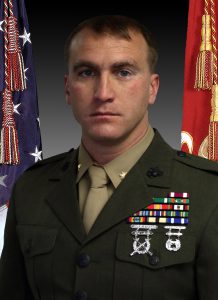
Maj. Brian Hubert
Hubert attended basic officer training and infantry officer training before reporting to 2nd Battalion, 1st Marines in Camp Pendelton, Calif., serving as the 81mm Mortar Platoon Commander and Weapons Company Executive Officer deploying on the 31st Marine Expeditionary Unit supporting operations in the Pacific.
His deployments include Operation Enduring Freedom to Yemen, where he served with the 1st Battalion, 1st Marines, and Operation Freedom’s Sentinel to Afghanistan, where he served with the 6th Marine Regiment with Task Force Southwest as a Joint Terminal Attack Controller and Battle Captain. Currently, he is serving as commanding officer of the Marine Recruiting Station in Cleveland.
His awards and decorations include a Meritorious Service Medal, Navy/Marine Corps Commendation Medal, and three Navy/ Marine Corps Achievement Medals.
“On Veterans Day, the United States pays tribute to all veterans who have served or are serving in the U.S. Armed Forces,” said Charles Hiser, executive director of the Lucas County Veterans Service Commission. “A veteran is someone who has given up years of their life to serve in the military, and the 17th annual Veterans Day Breakfast and Resource Fair is one way locally we can show veterans our support.”
In addition to the free breakfast, local veterans and members of the military and their families will have access to more than 30 military-friendly community resources.
The program will feature entertainment by Gabriel Hagedorn, a UToledo student and pianist, and fourth-graders from Waterville Primary School.
Members of the Rossford High School S.O.S. (Serving Our Soldiers) Club will greet and assist veterans through the breakfast line.
Free parking will be available in lots 3, 5 and 6 near Savage Arena.
For more information on the event, contact the UToledo Office of Special Events at 419.530.2200 or specialevents@utoledo.edu.
U.S. Department of Energy Invests in UToledo Solar Technology Research
November 2nd, 2021 by Christine BillauIn the race against climate change, physicists at The University of Toledo are pushing the limits of solar electricity to ensure a clean energy future.
Through an innovative project that combines two types of solar cells and harvests light not only from the sun, but also light reflected off the ground, researchers are creating technology to develop stronger and longer-lasting solar panels.
UToledo is a world leader in the investigation of an advanced material called perovskites, a compound material with a special crystal structure that can be used to create less expensive and highly efficient solar cells.
The U.S. Department of Energy awarded UToledo a one-year, $300,000 grant to advance research that could lead to the integration of promising perovskite solar cell technology into existing production lines for cadmium-selenide-telluride (CST)-based solar cells, maximizing the performance of thin-film tandem solar cells and reducing the costs of energy.
UToledo’s work aims to collect light from both the front and back faces of the solar panel while interconnecting layers of perovskites and CST cells on both the front and the back faces of the solar panel. UToledo has a patent pending on the technology called the monolithic bifacial perovskite-CST tandem cell.
The team is led by Dr. Zhaoning Song, research assistant professor in the College of Natural Sciences and Mathematics, and Dr. Yanfa Yan, Distinguished University Professor of physics, who previously set the world record for the conversion of sunlight to electricity using perovskites and increased total electrical power generated by using two different parts of the sun’s spectrum.
“Based on theoretical calculation, the monolithic bifacial tandem design can boost the output power density limit of conventional CST solar modules by up to 50% with a light color concrete ground,” Song said. “Our proof-of-concept device demonstrated a greater than 25% conversion efficiency improvement.”
UToledo’s project is one of 40 across the country selected for funding by the U.S. Department of Energy Solar Technologies Office out of a total of nearly $40 million invested to advance the next generation of solar, storage and industrial technologies necessary for achieving the Biden administration’s climate goal of 100% clean electricity by 2035.
“We are laser focused on deploying more solar power and developing more cost-effective technologies to decarbonize our electricity system,” said Secretary of Energy Jennifer M. Granholm. “Research to develop stronger and longer-lasting solar panels is critical to addressing the climate crisis.”
Specifically, the projects will reduce the cost of solar technologies by increasing the lifespan of photovoltaic systems from 30 to 50 years, developing technologies that will enable solar to be used in fuel and chemical production.
“Northwest Ohio continues to play a leading role in shaping the national and global response to the crisis of climate change,” said U.S. Representative Marcy Kaptur, who serves as chair of the House Appropriations Subcommittee on Energy and Water Development. “The University of Toledo is on the front lines of this effort, and its work to advance next-generation solar technologies will play a critical part in delivering the affordable, reliable, low-emission energy we need for our success in the 21st century.”
‘Climate Change and the Great Lakes’ Topic of Great Lakes Water Conference Nov. 5
October 29th, 2021 by Christine BillauThe impact of climate change on the Great Lakes as well as recent developments in climate change law and policy is the focus of the 21st Annual Great Lakes Water Conference at The University of Toledo.
The conference titled “Climate Change and the Great Lakes” will be conducted online as a live webinar Friday, Nov. 5, from 9 a.m. to 12:30 p.m.
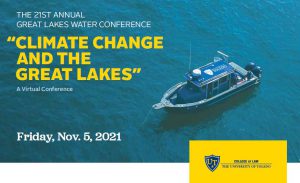 The conference is sponsored by the UToledo College of Law and its Legal Institute of the Great Lakes.
The conference is sponsored by the UToledo College of Law and its Legal Institute of the Great Lakes.
“Climate change is a global problem, but its impacts are felt locally,” said Ken Kilbert, professor of law and director of the Legal Institute of the Great Lakes.
The conference will feature Kim Channell, a climatologist at the University of Michigan’s Great Lakes Integrated Sciences and Assessments. Channell will discuss the impacts of climate change on the Great Lakes region, especially its water resources. Other speakers will address various aspects of climate change law and policy in the United States and Canada.
Registration for the half-day conference is free for the public and $50 for attorneys seeking 3.0 hours of Ohio Continuing Legal Education (CLE) credit.
For more information about the conference and to register by Nov. 3, visit utoledo.edu/law/events/great-lakes.
UToledo to Launch National Search for Athletic Director
October 28th, 2021 by Christine BillauThe University of Toledo is launching a national search for the next vice president and director of athletics to replace Mike O’Brien, who is retiring from the position at the end of his contract April 30, 2022.
UToledo is partnering with Collegiate Sports Associates, an executive search firm specializing in intercollegiate athletic hiring for colleges and universities.
The company has helped with several searches in the Mid-American Conference (MAC) recently, including the University of Akron, Miami University and Ball State University, as well as national searches for the University of Cincinnati, the University of Georgia and Michigan State University.
“Under Mike O’Brien’s leadership, Rocket Athletics has developed a reputation for excellence in the classroom and on the field,” UToledo President Gregory Postel said. “We must maintain this momentum and build upon our history of success. We are looking for a leader that shares Rocket Nation’s enthusiasm, as well as a commitment to our institutional values including student-centeredness and diversity.”
Douglas Huffner, associate vice president for risk management and chief risk officer, is the chair of UToledo’s search committee. Also serving on the committee will be:
- Jeff Cole, UToledo alumnus and senior director of corporate communication at Dana Incorporated;
- Dana Hollie, professor of accounting in the UToledo John B. and Lillian E. Neff College of Business and Innovation and faculty athletics representative to the MAC and NCAA;
- Brian Jones, senior associate athletic director for health and wellness;
- Don Mewhort, UToledo alumnus and community business leader;
- Collin Palmer, director of undergraduate admission;
- Demond Pryor, director of recreational services;
- Robert Steven, senior lecturer in the UToledo Department of Biological Sciences and member of Faculty Senate;
- Madeline Vining, UToledo junior majoring in economics and student-athlete competing in track and field; and
- Thomas Wakefield, director of the Frankel Cardiovascular Center at the University of Michigan and a member of The University of Toledo Foundation Board.
“Our committee represents UToledo’s campus community ranging from a student’s perspective to faculty, staff, alumni and donors,” Huffner said. “I am confident our experiences and expertise we bring to the table will help us find the next great leader for the Rocket athletic program, one of the best in the MAC and one of the top mid-major athletic programs in the nation.”
Under O’Brien’s watch, the Rockets have won or shared 36 league titles in nine different sports. In addition, the Rockets have made 11 bowl appearances in football, four NIT appearances in men’s basketball, an NCAA Tournament appearance in women’s basketball in 2017, as well as eight WNIT appearances, including a WNIT championship crown in 2011. Toledo won the Jacoby Trophy as the MAC’s top women’s athletic program in 2011-12 and 2017-18.
In the classroom, Toledo has produced overall department GPAs above a 3.3 in each of the past four semesters, including a school-record GPA of 3.527 in spring 2020. Toledo has won the Mid-American Conference Institutional Academic Achievement Award, presented annually to the school with the highest GPA, in five of the last eight years.
Email ADSearch@utoledo.edu to give feedback to the search committee.
UToledo Engineer Selected to Help Make U.S. Navy Ships More Fuel Efficient
October 28th, 2021 by Christine BillauA researcher at The University of Toledo is using a unique semiconductor material to both shrink technology and cut energy use to help the U.S. Navy become more fuel and energy efficient.
The Office of Naval Research (ONR) awarded Dr. Raghav Khanna, associate professor in the Department of Electrical Engineering and Computer Science, a 3-year, $510,000 grant to design circuits that are smaller in size and more efficient for electric Navy ships and aerospace systems.
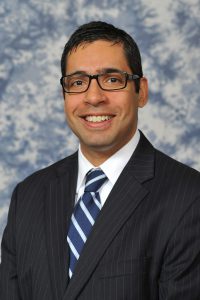
Dr. Raghav Khanna, associate professor in the Department of Electrical Engineering and Computer Science
ONR, a funding agency within the U.S. Department of Defense, has awarded this grant to Khanna to encourage collaboration with the U.S. Navy’s corporate research laboratory, the U.S. Naval Research Laboratory (NRL).
“We are proud to collaborate with the NRL on a project critical to both sustainability and national security,” Khanna said. “Fuel economy and power efficiency translate to operational flexibility for our military.”
Silicon is the most common component in power devices, but Khanna’s team will design circuits using instead gallium nitride to be applied to what’s called direct-current (DC) microgrids for electric Navy ships. The goal is to help make up to 20 kilovolt gallium nitride (GaN) power electronic devices to facilitate power distribution.
Khanna said next-generation microgrids, self-contained power distribution grids that can be on land running off solar and wind or on an electric navy ship at sea, will benefit from DC electricity.
Conventional power distribution grids run off alternating-current (AC), however, with the advent of newer circuit materials such as gallium nitride, research suggests that DC microgrids may be the power architecture of the future.
Gallium nitride technologies have been shown to deliver a higher performance compared to their silicon-based counterparts, particularly in DC microgrids, while reducing the energy and physical space needed to achieve that performance.
“Gallium nitride can operate at much higher voltages, frequencies and temperatures,” Khanna said.
To be able to realize the high-voltage potential of future DC microgrid architectures, high-voltage power electronic devices are needed, such as the devices Khanna is modeling.
Khanna is modeling what the materials would look like and simulating how they would work, and the Naval Research Laboratory will take the UToledo models and fabricate the devices.
“Dr. Khanna and his group have been able to develop experimentally validated simulation models of these important high voltage GaN devices,” said Dr. Andrew Koehler, electronics engineer at the Naval Research Laboratory. “Their models allow them to closely examine the physics that govern the device’s operation, allowing innovation of new approaches to improve performance, manufacturability and reliability, which we can implement into our design and fabrication process.”
The technology is being designed to be used aboard Navy ships for power generation systems, weapons systems and communications systems, which can all be electrified.
“We’ll start with a 1-kilovolt device, and gradually move up to 5, 10 and 15. This will allow us to develop learning cycles at each incremental voltage, and hopefully the process will get faster and faster as we fulfill each milestone. By the end of three years, we hope to have a 20-kilovolt gallium nitride-based device,” Khanna said.
One 20 kilovolt gallium nitride device can provide power for at least 20 Tesla car batteries.
Khanna, who focuses his research on next-generation power electronics, also is using gallium nitride in a NASA-funded project to improve power for space exploration. He will be internally collaborating with faculty within the UToledo College of Engineering who have expertise in materials to help achieve these objectives for both the U.S. Navy and NASA.
Prior to joining UToledo in 2015, Khanna worked for HRL Laboratories LLC in California where he was directly involved with the development of gallium nitride-based battery chargers for electric vehicles.
UToledo to Host Dialogue on Diversity to Discuss Critical Race Theory
October 26th, 2021 by Christine BillauThe University of Toledo is continuing its Dialogues on Diversity series with a conversation about critical race theory.
The virtual event, which is the 17th in the series, is titled “Critical Race Theory, Explained” and will take place 6 p.m. Thursday, Oct. 28, on Webex.
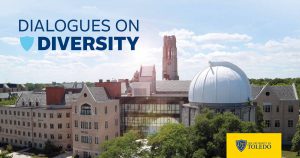 The discussion will explore critical race theory as an academic theory to explain practices that disadvantage some while rewarding others.
The discussion will explore critical race theory as an academic theory to explain practices that disadvantage some while rewarding others.
Panelists include Dr. Monita Mungo, assistant professor of sociology, and Aaron Baker, doctoral candidate in educational psychology and co-chair of the Judith Herb College of Education Diversity Committee.
“Existing for decades, critical race theory has found renewed popularity in current social discourse,” Mungo said. “Experts from sociology, education and political science will explain what critical race theory is and how it is useful as a framework to examine the social production of unequal and unjust outcomes for racialized groups.”
The discussion will be moderated by Quatez Scott, dean’s fellow in the College of Graduate Studies and Ph.D. student in the Social and Philosophical Foundations of Education program.
The UToledo Office of Diversity and Inclusion organized the event.
UToledo launched the Dialogues on Diversity series in 2020 after George Floyd was killed in Minneapolis by a police officer, sparking protests nationwide against systemic racism.
The University of Toledo is a community that celebrates and respects people of all backgrounds and experiences. As an institution, we remain committed to building an inclusive environment free of racism, sexism, bigotry and other negative influences.

